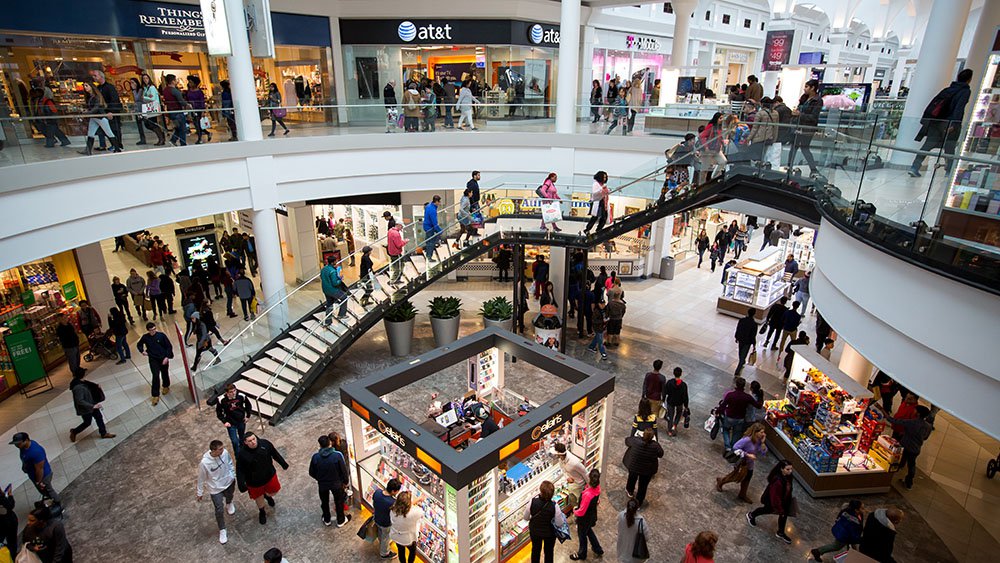Traditional retailers, whose obituaries have been started and scrapped for years, are on the critical list again, with stores shuttering and e-commerce giants like Amazon.com (AMZN) in ascendance.
Executives say put the death notices away, at least for one category. Malls aren’t going extinct — they’re changing, sometimes by healthy natural selection. While store closures are painful, often they represent a Darwinian moment, allowing a shopping center to refresh its mix by adding a grocery market or an Apple store.
Investors aren’t buying it. Literally. Mall REIT stocks have dropped 18% in the past year, compared with a 4% gain in the broader REIT group, as stores close at a record pace. At the same time, a view is building among industry analysts that skepticism has gone too far.
Down 7% this year, Bloomberg’s BBREIT Regional Mall Index trades for 5.1 times book value, down from its 2016 high of 6.7 and roughly in line with its decade average.
New York University’s REIT Symposium on April 6 featured presentations from chief executive officers at 27 REITs spanning numerous industries. But the conversation kept bouncing back to retail. Here’s what the executives had to say:
Not All Retail Is Created Equal
Retail properties come in many varieties, and shouldn’t be lumped together. Malls aren’t the same as strip centers, and, more importantly, high-quality malls — or “A” malls — are different from “B” and “C” malls. The consensus is that the high-quality malls will outperform.
“If you own the best real estate, you will thrive,” said Sandeep Mathrani, CEO of mall operator GGP (GGP). Retailers no longer care whether they’re operating out of a strip center or a mall, he said. Quality is what matters. And of the 7.5 billion square feet of retail real estate in the U.S., only 1.2 billion is currently occupied by stores that are considered high quality, Mathrani said.
It’s All About Experience and Location
When it comes to malls, “high quality” has been synonymous with luxury apparel brands. But the definition is changing as e-commerce puts a premium on creativity. A trip to the mall is no longer just about buying a designer handbag. Now it often involves going to a grocery store, doctor’s office or upscale restaurant — all businesses that face less risk from e-commerce than traditional tenants. Some REITs are tacking on office space or apartments to diversify. One mall in Dubai even boasts an aquarium and an Olympic sized ice rink, and another features a ski slope.
Mathrani said today’s ideal mall includes one department store, a supermarket, an Apple store, a Tesla store, and businesses that started out online, such as Warby Parker. Clothing stores, which used to take up about 70% of the average shopping center, now represent closer to 50%, he said. Meanwhile, food is roughly 15%, up from around 6%.
“Food is the new fashion, and fitness is the new food,” said Acadia Realty Trust (AKR) CEO Kenneth Bernstein.
Shoppers also aren’t willing to travel as far as they once were for a day at the mall, so location and convenience are important. “Old-fashioned retail shopping centers will continue to exist as long as they’re in the right location,” Mathrani said.
Out With the Old, In With the New
Store closures such as those at Sears Holdings (SHLD) and J.C. Penney (JCP) have driven a lot of the recent negativity around retail, but some REITs have said good riddance. The exit of one retailer can present an opportunity to boost rents and lease space to a higher-quality store.
Mathrani said that GGP had anticipated the fall of some stores, and has been able to fill 80% of the space that was left empty when retailers went bankrupt. Stores like Bonobos, Lululemon (LULU) and Warby Parker have filled the gaps.
Technological innovation can also open doors, according to Conor Flynn, CEO of shopping center REIT Kimco Realty (KIM). He said driverless cars and ride-sharing could allow his company to transform parking lots into apartments and hotels.
Over-Retailed and Under-Demolished
Some REIT executives said the U.S. has too much retail space. Flynn said a lot of shopping centers were built to keep up with household formation, but many of those households were never built. So as e-commerce continues to take more market share, parts of the country may need to do some demolition. In the future, the city you live in may have four malls instead of eight. The key, Flynn said, is having a good business both in stores and online.
“Home Depot (HD) is a perfect example of being very efficient at both the physical bricks-and-mortar as well as the e-commerce business,” he said. “There is an omnichannel wave now that is widely accepted by most consumers.”
by

